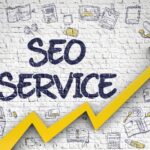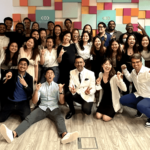Is not aware of our brand, but is not on our radar as a prospect. As B2B marketers, you’re well-aware that sales don’t happen in an instant. Your buyers go through a series of stages before they decide to do business with your company.
In this article, you will learn about the different customer lifecycle stages and how to create a personalised content strategy to move buyers to the next stage. What’s more, you can also download a proven customer lifecycle marketing framework template we use for our clients.
What are Customer Lifecycle Stages?
Imagine meeting someone for the first time and asking them to marry you. It doesn’t happen, does it? The same logic applies to customer relationships.
To convert prospects into buyers, it’s important to understand the various stages your buyers go through.
In the dating scenario, you meet someone and go on a couple of dates before you decide to get married and have children. In this case, prospects become leads, leads become qualified and turn into opportunities before they become clients.
This is exactly what customer lifecycle stages are.
Customer lifecycle refers to the strategies brands use to attract, nurture, convert, and retain buyers.
The purpose of these strategies is to deliver an engaging experience through a series of personalised content, thereby driving revenue and building strong customer relationships.
Customer Lifecycle vs Customer Journey
“What’s the difference between customer lifecycle and customer journey,” you might wonder.
Customer journey refers to the set of experiences a customer goes through from the time they become aware of your brand. It is typically broken down into:
- Awareness
- Consideration
- Decision
Source: HubSpot
On the other hand, customer lifecycle is a tool marketers use to get detailed insights into customer behaviours and decisions.
Customer lifecycle management is an ongoing process to identify which stage your customers are in so you can influence them to take them to the next stage
It’s safe to say that the customer journey encompasses what your customers experience whereas the customer lifecycle is more of an internal strategy marketers implement to turn prospects into customers.
What are the Stages of Customer Lifecycle?
The B2B customer lifecycle can be broken down into six key stages. Each stage is unique in terms of customer needs and behaviors, thereby demanding a unique strategy.
For starters, here’s a customer lifecycle framework template you can download and implement. This is a framework we created for a gift supplier client of ours. Let’s call them Company X.
Make sure you customise it for your own business.
To start, you can download the Customer Lifecycle stage template by filling up the form below

This is what the template looks like
Now, let’s take a deeper look into the six customer lifecycle stages along with the corresponding marketing strategies you can implement.
1. Stranger
Definition
Someone who is not aware of your brand and is not on your radar as a prospect.
Goal
To build awareness and get your brand in front of prospective customers.
Marketing strategies
‘Strangers’ comprise of people who don’t know anything about your brand. At this stage, you need to reach out to prospective customers, create brand awareness, and get your brand in front of them.
You need to educate and inform potential buyers about your brand and generate enough interest in them, compelling them to engage with you.
Here are a few marketing tactics you can implement to convert strangers:
- Advertise on relevant social media channel
- Run search and display ads
- Run remarketing campaigns
- Create informative blog posts
- Publish guest posts on websites that speak to a similar audience
The idea is to reach your target audience where they are. While running ads, make sure the targeting and content you’re promoting are aligned with your buyer personas.
The goal of these ads or the content you create needs to be geared towards encouraging potential buyers to subscribe to your newsletter or leave an inquiry.
In the case of Company X, we ran paid search and remarketing ads with an aim to direct ‘Strangers’ to the company website. We wanted them to sign up to the newsletter or leave an enquiry.
| Stage | Definition | What is the call-to-action? | How do we intend to reach out these people? | Next plan of action |
| Stranger | Is not aware of our brand, but is not on our radar as a prospect. | Visit the Company X website | Paid ads on search and remarketing | To either sign up to newsletter OR leave an enquiry |
Here’s an example of an awareness ad on Facebook that aims to educate the audience about the product.
2. Subscriber
Definition
Someone aware of your brand and not yet on your radar as a prospect.
Goal
To convert website visitors into email subscribers.
Marketing strategies
Your awareness ads are driving traffic to your website and people are no longer oblivious about your brand but is that enough? Not quite.
It’s alarming to note that an average website sees 98% of anonymous visitors. This means that 98% of your website visitors land on your website, browse around, and leave without a trace.
The purpose of this stage is to convert those anonymous website visitors into email subscribers. Subscribers are those who opt in to hear more from you by signing up for your blog or newsletter.
It’s important to collect your prospects’ email addresses and build an email list because it enables you to develop a long-term relationship with your prospects.
Here are a few marketing tactics you can implement to convert website visitors into subscribers:
- Encourage visitors to subscribe to your newsletter or blog
- Create a landing page for newsletter or blog subscription
- Place strategic call-to-actions across key areas on your website
- Simplify subscription forms, making it easy for people to fill
In the case of Company X, prospects who had seen and engaged with the content by liking, sharing or commenting on it were encouraged to sign up to the newsletter.
| Stage | Definition | What is the call-to-action? | How do we intend to reach out to these people? | Next plan of action |
| Subscriber | Is aware of our brand, but is not yet on our radar as a prospect. | Has seen our content and interacted with it by liking, sharing, subscribing. | Website newsletter signup. | To leave an enquiry |
Here’s an example of how we at Brew Interactive encourage website visitors to subscribe to our blog. The form is simple and is placed in blog posts.
3. Marketing Qualified Lead
Definition
A lead who shows interest in your brand as a result of your marketing efforts.
Goal
Attain personal information from them and deliver relevant, gated content that addresses their pain points.
Marketing strategies
All leads are not equal. For instance, marketing qualified leads (MQLs) are leads that have shown interest in your business based on your marketing efforts. They might have:
- Downloaded content such as eBooks, whitepapers, templates, checklists, etc.
- Shared their information through a lead generation ad
- Contacted you, requesting for more information
- Visited a particular web page on your website multiple times
MQLs are closer to the ‘consideration’ stage in the funnel because they aren’t sales-ready. At this stage, you need to acquire more information about them so you can deliver additional content that’s relevant to their needs.
For instance, for the gift supplier client of ours, we established MQLs to be those who were in the exploratory phase and were in the market to find gifts but didn’t have a budget or timeline in mind.
We ran search engine marketing campaigns and remarketing ads to attain their budget, timeline, and involve the decision-makers.
| Stage | Definition | What is the call-to-action? | How do we intend to reach out to these people? | Next plan of action |
| Marketing Qualified Lead | Is in the early exploratory phase. He/she is in the market to find corporate gifts, but does not have a budget, nor timeline. Typically, a first time purchaser | Sales person to manually mark it as such | SEO, SEM, Remarketing Ads | To get their budget, timeline and other decision makers involved |
Here are some of the marketing tactics you can implement:
- Create gated content such as eBooks, case studies, whitepapers, webinars, etc.
- Focus on improving your website’s SEO and driving organic traffic
- Run search engine marketing campaigns
- Run remarketing ad campaigns across channels
Here’s an example of how Salesforce is acquiring MQLs by hosting a webinar.
4. Sales Qualified Lead
Definition
A lead who has shown interest in making a purchase or has high potential in converting into a customer.
Goal
To continue nurturing them with valuable and relevant content.
Marketing strategies
Sales qualified leads (SQLs) are one step ahead of MQLs. They have indicated a clear interest in becoming your customer and now that you have identified their pain points, you need to continue nurturing them with valuable content that addresses those pain points.
The idea is to position your brand as the solution to their needs and influence them to be sales-ready.
Talking about our gift supplier client, we established SQLs to be those who had a budget, timeline, and quantity set aside. They had a clear purpose behind buying gifts and wanted more gifting recommendations.
On getting their confirmation on the budget and timeline, we sent them samples and design proposals, showing them what the product looks like with their brand name on it.
| Stage | Definition | What is the call-to-action? | How do we intend to reach out to these people? | Next plan of action |
| Sales Qualified Lead | Has budget + timeline + quantity set aside, and knows why they are buying corporate gifts (ie. usages), but wants to hear recommendations on the types of gifts available | Sales person to manually mark it as such | SEO/SEM, Remarketing Ads, Email | Show proposal on the types of products available. Get confirmation on what they want, their budget, and timeline, so we can either send samples OR design proposal (ie. Show how the product looks like with the brand name on it) |
Here are a few tactics you can implement to generate SQLs:
- Create content in line with their pain points and needs
- Offer product demos and free trials
- Focus on long-tail keywords to drive traffic with high search intent
- Nurture them through email marketing workflows
- Use marketing automation tools such as Pardot, HubSpot, etc.
Take a look at this example by Drift where they are offering a free demo to acquire SQLs.
5. Opportunity
Definition
An engaged and qualified prospect who shows a high probability of becoming a customer.
Goal
To show them why your product or service addresses their needs or pain points and ensure they’re ready to buy.
Marketing strategies
Sales qualified opportunities are one step away from becoming your customer. They have expressed their interest in buying from your company and want to continue the conversation.
They are aware of what they want and you need to ensure they’re ready to buy.
In the context of our gift supplier client, we established an opportunity to be someone who knew exactly what to buy. The next plan of action for this group of people was to send them a quote or invoice.
Here are some tactics you can implement at this stage:
- Nurture them through email marketing workflows
- Run remarketing and search engine marketing campaigns
- Encourage them to speak to sales representatives or give them individualized attention
| Stage | Definition | What is the call-to-action? | How do we intend to reach out to these people? | Next plan of action |
| Opportunity | Already has the budget, timeline, knows exactly what to buy | Sales person to manually mark it as such | SEO/SEM, Remarketing Ads, Email | Sign quote / Invoice |
6. Customer
Definition
Someone who has purchased from you at least once.
Goal
To encourage repeat purchases, retain customers, and build loyalty.
Marketing strategies
Your relationship with your customers doesn’t end with a purchase. It’s important to retain those customers, upsell to them, and encourage repeat purchases.
You need to provide them with ongoing support to keep them happy and encourage them to not only buy from you again but also be a brand advocate.
Here are some tactics you can implement at this stage:
- Offer content in the form of useful tips and information on the latest launches
- Create FAQs and other support documentation
- Offer discount coupons
- Develop a loyalty program and reward loyal customers
- Run email marketing, remarketing, and WhatsApp marketing campaigns
In the case of Company X, we served customers with remarketing ads along with email newsletters and WhatsApp messages, encouraging them to leave reviews on Google and fill up a customer survey.
| Stage | Definition | What is the call-to-action? | How do we intend to reach out to these people? | Next plan of action |
| Customer | Has already purchased once from Company X | Completed first purchase | Email, WhatsApp, Remarketing | Fill up customer survey/Google Reviews |
Here’s an example of a customer retention strategy by Avocode where they are offering a discount.
Source: Really Good Emails
Final Thoughts
Customer lifecycle is an ongoing, cyclical process. As potential customers move from one stage to the next, their needs change.
It’s essential to categorize your prospects into these six key stages and implement the right marketing tactics to take them to the next stage while keeping them invested in your brand.





